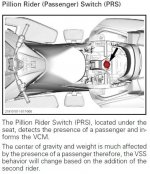Ray, most who've felt this 'small load' or 'passenger aboard' intervention
might be an issue have had success by inserting a spacer or bump stop around/in the pressure switch, so that the switch remains active & its wiring/connection to the VSS/various computers exactly as intended, but the pressure switch just won't ever depress enough to trigger the 'passenger aboard' safe-guards. :thumbup:
It's not hard to do - fitting a piece of PVC pipe that's just large enough to fit snugly around the 'button' and tall enough to limit how far it can be pressed down by a load will do the trick; or installing a bump stop or three mounted under the seat & on the frame to support the seat at the 'no passenger' height &/or around the button to stop it ever being pressed down whenever a load is applied to that seat....

No issues with Limp Mode kicking in cos the wiring isn't connected or the switch isn't working; and no changes to the solo riding parameters either! And to add the icing to the cake, the PVC Pipe method is easy enough to remove whenever you
DO actually have a real pillion passenger aboard too - simply remove the short length of Pipe from around the switch & all the 'passenger aboard' safe-guards are back in action.

That said, you really should be aware that the '
passenger aboard' changes to the VSS parameters don't
JUST reduce power & encourage the Nanny to step in a little earlier; they also vary the way the brakes apply, esp in the front to rear braking effort ratio; and change the parameters for both EBD & ABS intervention to maximise your braking, and those changes to cater for even a relatively small weight sitting waaay back there on the pillion seat & cantilevered out over the rear wheel like it is
CAN mean the difference between stopping in time to avoid a suddenly encountered 'road hazard' or smacking into the proverbial 'immovable object' while you're still travelling at enough speed to make that impact potentially critical! :lecturef_smilie:
Me, I left the Passenger Aboard switch completely alone, so it still does
everything it was designed to do as & when that's warranted, but I got an ECU Upgrade that
more than compensates for any degradation in performance with a pillion aboard! Best of both worlds... in fact, I reckon a proper ECU Upgrade done by someone who knows their business is even
BETTER than 'the best of both worlds'!

hyea:

